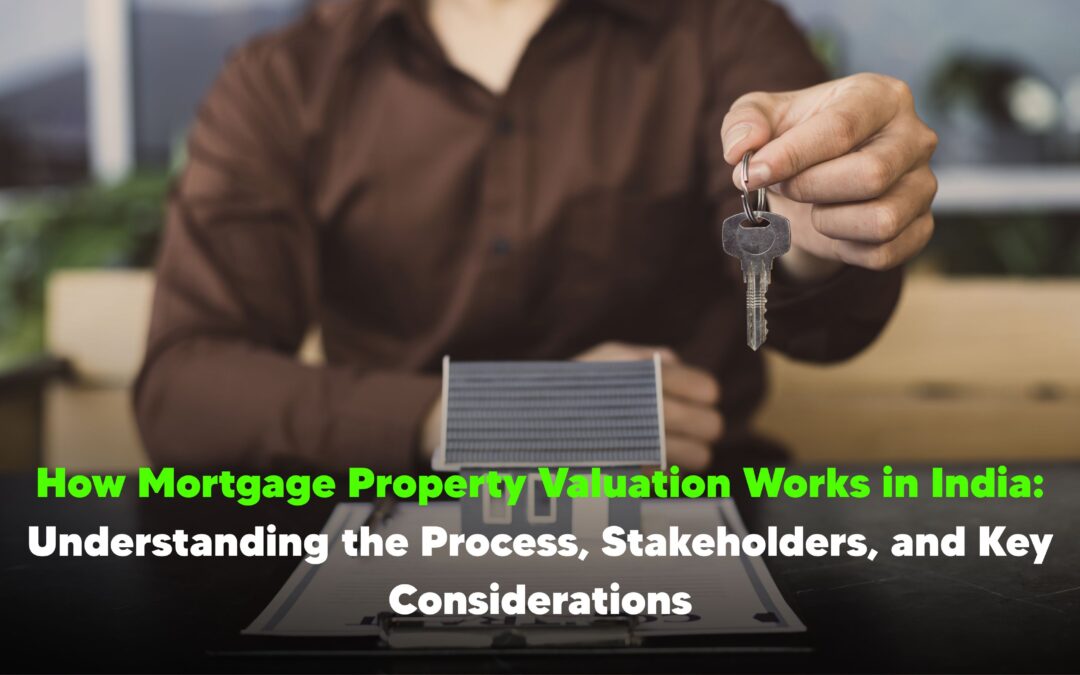Accurate and reliable property valuation forms the cornerstone of mortgage financing in India. Whether for residential or commercial needs, lenders rely heavily on independent valuations to assess risk, determine credit limits, and finalize loan terms. This article delves into the fundamentals of mortgage property valuation in India, highlighting the stakeholders involved, the valuation methodologies, the considerations at each stage, and how this process applies to Commercial Property.
1. The Significance of Mortgage Property Valuation
Mortgage property valuation is a formal assessment of a property’s worth, conducted primarily to assist lenders in making loan-related decisions. For mortgage applicants, it ensures that the lender’s advance is proportionate to the property’s value, minimizing risk. For lenders, it protects their financial investment by ensuring they do not over-lend.
In the context of Commercial Property, this valuation becomes even more pivotal. The complexity of business usage, rental income projections, and potential for redevelopment necessitates a refined approach to valuation.
2. Key Stakeholders in the Valuation Process
Understanding the mortgage valuation process requires recognizing the roles of different stakeholders:
- The Borrower: Initiates a loan application and may engage the valuer or allow the lender to appoint one.
- The Lender: Instructs the valuation to confirm that the loan amount is justified by the property’s market value.
- The Registered Valuer: A professional appointed by the lender—or sometimes by the borrower—who conducts the valuation following the guidelines of the Insolvency and Bankruptcy Board of India (IBBI).
- Regulators: Bodies like the Reserve Bank of India (RBI) and IBBI ensure that valuations meet statutory standards and professionals adhere to compliance norms.
3. The Valuation Process: Step by Step
3.1 Instruction and Documentation
Once the loan application is initiated, the lender engages a registered valuer. Necessary documents include:
- Property title deeds
- Sale agreement or conveyance deed
- Building approval plans
- Encumbrance certificate
- Rent receipts (if property is leased)
- Occupancy or completion certificate
Completeness of documentation is essential; missing or unclear documents can delay the valuation or even lead to rejection.
3.2 Site Visit and Physical Inspection
The valuer conducts a site visit to inspect the property’s location, physical attributes, construction quality, current usage, potential for expansion, and marketability. In the case of Commercial Property, this visit is especially critical—understanding layout, rental potential, accessibility, zoning, and compliance with licensing norms shapes the valuation.
3.3 Market Research and Comparative Analysis
To estimate value, the valuer compares similar properties (comparable or “comps”) that have recently transacted in the vicinity. For commercial assets, comparisons often involve rental yield, operational expenses, tenant mix, and occupancy rates. Adjustment factors—like age of structure, amenities, frontage, and land-to-built-up ratio—are applied to ensure fairness in comparison.
3.4 Application of Valuation Approaches
Valuers adopt one or a combination of three main methodologies:
- Market Approach: Understanding value through comparison with recent transactions of similar properties.
- Income Approach: Particularly relevant in Commercial Property, this method projects rental income, deducts operating costs, and applies a capitalization rate to derive net present value.
- Cost Approach: Calculates the cost to rebuild or replace the property, minus depreciation, plus land value. This is often a fallback if comparable market data is sparse.
3.5 Report Generation
The valuer creates a detailed report that includes:
- Property description and legal status
- Valuation methodology and rationale for approach chosen
- Market comparison and benchmarking data
- Estimates of market value and, sometimes, forced sale value
- Any assumptions or limitations in the valuation
The report must comply with IBBI valuation standards and include disclosures regarding any conflicts of interest or assumptions made.
4. Methodologies in Detail: Choosing the Right Approach
Market Approach
The most transparent and widely used method when comparable sales data exists. Its accuracy depends on the depth and relevance of local data. In dynamic urban centers, this method can yield timely valuations for both residential and Commercial Property.
Income Approach
Highly relevant for investment-driven assets. Analysts forecast rental returns, adjust for vacancy rates and maintenance costs, and apply a capitalization rate (market-determined). The resulting figure represents the income-generated worth of the property—especially helpful for projecting investor returns.
Cost Approach
Useful when properties are unique or markets lack data, such as new commercial developments. This method requires sound estimates of reconstruction costs and depreciation—a nuanced exercise when valuing office complexes, retail spaces, or industrial facilities.
5. Legal and Regulatory Framework
India’s property valuation sector operates under a stringent regulatory architecture:
- IBBI (Insolvency and Bankruptcy Board of India): Regulates and accredits registered valuers, ensuring they adhere to valuation standards and ethical norms.
- RBI Guidelines: Mandate lenders to rely exclusively on valuations conducted by independent, registered professionals.
- Real Estate (Regulation and Development) Act, 2016 (RERA): Applies to Commercial Property projects, mandating transparency in disclosures and property details, which aids in accurate valuations.
These frameworks ensure that valuations are standardized, credible, and aligned with national legal norms.
6. Common Challenges and Pitfalls
- Insufficient Comparable Transactions: In markets with sparse data, market-based valuations become difficult, potentially skewing estimates.
- Dynamic Market Conditions: Price swings, fluctuations in rental demand, or sudden shifts in interest rates can render valuations obsolete quickly.
- Complexity in Commercial Leases: Varied lease structures—like open rentals, triple net leases, or percentage rent portfolios—require careful interpretation.
- Tax Treatment Uncertainty: Stamp duties, municipal taxes, and GST implications may vary across jurisdictions and affect the net value realized.
- Regulatory Delays: Slow issuance of legal documents or occupancy certifications can delay the valuation timeline.
7. Value Additions: Enhancing Mortgage Property Valuation
For borrowers, substantiating the valuation can offer better financing terms. Value enhancements include:
- Third-Party Reports: Offering a broker’s market assessment or development appraisal can strengthen credibility.
- Lease Agreements: Providing rental contracts with tenants demonstrates tangible income streams.
- Certification Documents: Timely and complete certificates—like occupancy, environmental clearance, or fire safety clearance—boost confidence in the asset.
- Business Performance Metrics: If leasing a Commercial Property used for an operational enterprise (e.g., hotel or retail), disclosing operating income can justify higher mortgage values.
8. Impact of Valuation on Loan Terms
The evaluated property value directly shapes key loan parameters:
- Loan-to-Value (LTV) Ratio: Determines the lending threshold; in India, for residential properties, it can be up to 80-90%, while for commercial properties, it is typically lower—often around 65-75%.
- Interest Rate: A higher valuation reliability often leads to more favorable interest rates.
- Disbursement Schedule: Releases may be tied to valuation milestones—such as approvals or completion stages—especially in under-construction commercial development.
- Refinancing and Top-Ups: Accurate valuation enables borrowers to access additional funds against existing mortgages or refinance at better terms.
Conclusion
Mortgage property valuation in India is a detailed, methodical process governed by regulatory frameworks and driven by transparent assessment of value. For all property types—including Commercial Property—it plays a vital role in shaping financing decisions, managing risk, and facilitating smooth lending operations.
From understanding the steps—from document review to site inspection and report generation—to appreciating the roles of various stakeholders, borrowers and lenders can benefit from well-structured, accurate valuations. Properly executed, they enable fair deals, protect financial interests, and help unlock the full potential of property assets in India’s evolving real estate landscape.


